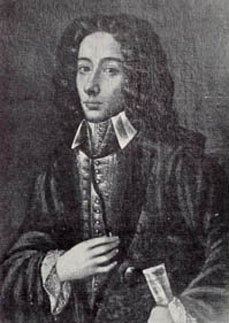| Giovanni Battista Pergolesi  Born: 4-Jan-1710 Born: 4-Jan-1710
Birthplace: Jesi, Italy
Died: 16-Mar-1736
Location of death: Pozzuoli, Italy
Cause of death: Tuberculosis
Remains: Buried, Cathedral, Pozzuoli, Italy
Gender: Male
Religion: Roman Catholic
Race or Ethnicity: White
Occupation: Composer Nationality: Italy
Executive summary: La Serva Padrona Italian musical composer, was born at Jesi near Ancona on the 3rd of January 1710, and after studying music under local masters until he was sixteen was sent by a noble patron to complete his education at Naples, where he became a pupil of Greco, Durante and Feo for composition and of Domenico de Matteis for the violin. His earliest known composition was a sacred drama, La Conversione di S. Guglielmo d'Aquitania, between the acts of which was given the comic intermezzo Il Maestro di Musica. These works were performed in 1731, probably by fellow pupils, at the monastery of St. Agnello Maggiore. Through the influence of the prince of Stigliano and other patrons, including the Duke of Maddaloni, Pergolesi was commissioned to write an opera for the court theater, and in the winter of 1731 successfully produced La Sallustia, followed in 1732 by Ricimero, which was a failure. Both operas had comic intermezzi, but in neither case were they successful. After this disappointment he abandoned the theater for a time and wrote thirty sonatas for two violins and bass for the prince of Stigliano. He was also invited to compose a mass on the occasion of the earthquake of 1731, and a second mass, also for two choirs and orchestra, is said to have been praised by Leo.
In September 1732 he returned to the stage with a comic opera in Neapolitan dialect, Lo Fratč Inammorato, which was well received; and in 1733 he produced a serious opera, Il Prigionier, to which the celebrated Serva Padrona furnished the intermezzi. There seems, however, no ground for supposing that this work made any noticeable difference to the composer's already established reputation as a writer of comic opera. About this time (1733-34) Pergolesi entered the service of the Duke of Maddaloni, and accompanied him to Rome, where he conducted a mass for five voices and orchestra in the church of St. Lorenzo in Lucina (May 1734). There is no foundation for the statement that he was appointed maestro di cappella at the Holy House of Loreto; he was, in fact, organist of the royal chapel at Naples in 1735. The complete failure of L'Olimpiade at Rome in January 1735 is said to have broken his health, and determined him to abandon the theater for the Church; this statement is, however, incompatible with the fact that his comic opera Il Flaminio was produced in Naples in September of the same year with undoubted success. His ill health was more probably due to his notorious profligacy. In 1736 he was sent by the Duke of Maddaloni to the Capuchin monastery at Pozzuoli, the air of the place being considered beneficial to cases of consumption. Here he is commonly supposed to have written the celebrated Stabat Mater; Giovanni Paisiello, however, stated that this work was written soon after he left the Conservatorio dei Poveri di Gesł Cristo in 1729. We may at any rate safely attribute to this period the Scherzo fatto ai Cappuccini di Pozzuoli, a musical jest of a somewhat indecent nature. He died on the 17th of March 5736, and was buried in the cathedral of Pozzuoli.
Pergolesis posthumous reputation has been exaggerated beyond all reason. This was due partly to his early death and largely to the success of La Serva Padrona when performed by the Bouffons Italiens at Paris in 1752. Charming as this little piece undoubtedly is, it is inferior both for music and for humor to Pergolesi's three-act comic operas in dialect, which are remembered now only by the air "Ogni pena pił spietata" from Lo Fratč Inammorato. As a composer of sacred music Pergolesi is effective, but essentially commonplace and superficial, and the frivolous style of the Stabat Mater was rightly censured by Paisiello and Padre Martini. His best quality is a certain sentimental charm, which is very conspicuous in the cantata L'Orfeo and in the genuinely beautiful duets "Se cerca, se dice" and "Ne' giorni tuoi felici" of the serious opera L'Olimpiade; the latter number was transferred unaltered from his early sacred drama S. Guglielmo, and we can thus see that his natural talent underwent hardly any development during the five years of his musical activity. On the whole, however, Pergolesi is in no way superior to his contemporaries of the same school, and it is purely accidental that a later age should have regarded him as its greatest representative.
Bibliography. The most complete life of Pergolesi is that by E. Faustini Fasini (Gazzetta Musicale di Milano, 31st of August 1899, etc., published by Ricordi in book form, 1900); G. Annibaldi's Il Pergolesi in Pozzuoli, vita intima (Jesi, 1890) gives some interesting additional details derived from documents at Jesi, but is cast in the form of a romantic novel. H. M. Schletterer's lecture in the Sammlung musikalischer Vorträge, edited by Count P. von Waldersee, is generally inaccurate and uncritical, but gives a good account of later performances of Pergolesi's works in Italy and elsewhere. Various portraits are reproduced in the Gazz. mus. di Milano for the 14th of December 1899, and in Musica e musicisti, December 1905. Complete lists of his compositions are given in Eitner's Quellen-Lexicon and in Grove's Dictionary.
University: Conservatorio dei Poveri, Naples
Do you know something we don't?
Submit a correction or make a comment about this profile
Copyright ©2019 Soylent Communications
|